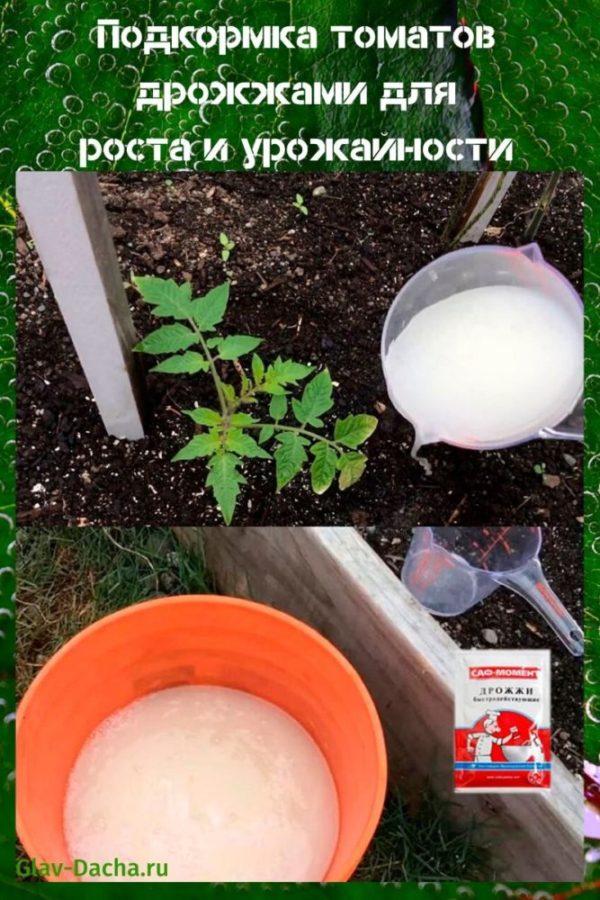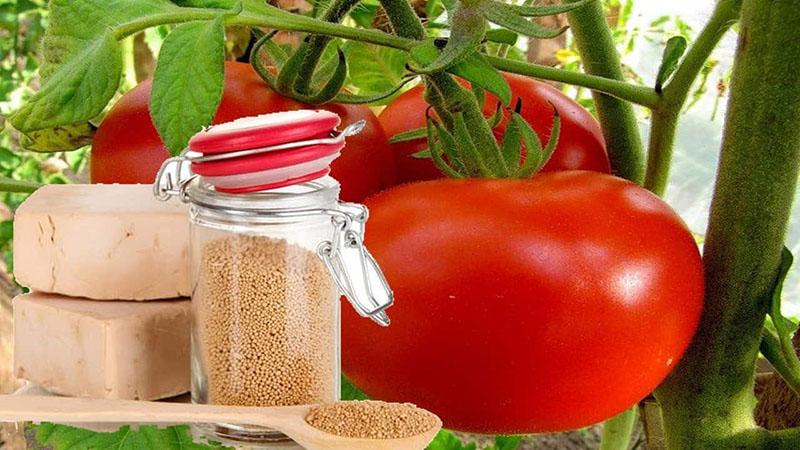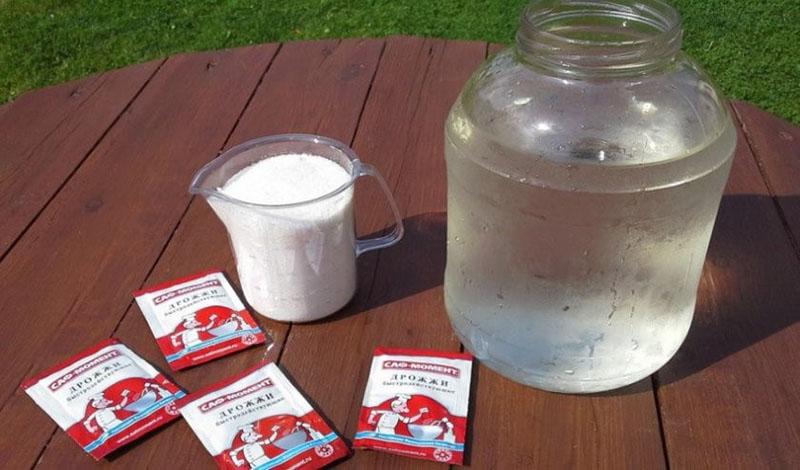Feeding tomatoes with yeast for growth and productivity
 Feeding tomatoes with yeast is a simple and effective way to accelerate plant growth and increase its yield, improve the structure of the soil, saturate it with useful microelements and proteins. Fertilizer from yeast can be used not only for "adult" bushes, but also for seedlings - it effectively stimulates its growth, accelerates adaptation to new conditions and ensures the full development of a healthy plant.
Feeding tomatoes with yeast is a simple and effective way to accelerate plant growth and increase its yield, improve the structure of the soil, saturate it with useful microelements and proteins. Fertilizer from yeast can be used not only for "adult" bushes, but also for seedlings - it effectively stimulates its growth, accelerates adaptation to new conditions and ensures the full development of a healthy plant.
Advantages and Disadvantages of Tomato Yeast

Benefits of tomato yeast feed:
- saturates the soil with nitrogen and phosphorus, improving its structure;
- stimulates the growth of seedlings and accelerates their adaptation to new soil;
- improves the growth of the root system and vegetative mass;
- increases the number of ovaries and fruiting of tomato bushes;
- strengthens the stems of the plant, making them healthy and developed;
- increases the taste characteristics of a tomato;
- increases the resistance of tomatoes to adverse weather conditions, various diseases and insect pests.
 Pouring yeast over tomatoes also has several disadvantages. This solution washes out calcium and potassium from the fertile soil, which plants need for full growth.
Pouring yeast over tomatoes also has several disadvantages. This solution washes out calcium and potassium from the fertile soil, which plants need for full growth.
Therefore, when using yeast, it is necessary to additionally enrich the soil. mineral fertilizers or ash.
Also, a significant disadvantage of yeast feeding is that, with regular use, it quickly depletes the soil - it provides rapid growth of tomatoes, but after a year the tomato harvest becomes scarce. That is why yeast must be alternated with other fertilizers - leaves, grass, straw.
Feeding tomatoes with yeast: timing
 Before fertilizing seedlings with yeast, you need to take into account the timing of fertilization, otherwise such treatment will not bring any results. Feeding tomatoes with yeast can be carried out already at the seedling stage, when the first green leaves appear on the sprouts - 7 days after planting young plants in open ground.
Before fertilizing seedlings with yeast, you need to take into account the timing of fertilization, otherwise such treatment will not bring any results. Feeding tomatoes with yeast can be carried out already at the seedling stage, when the first green leaves appear on the sprouts - 7 days after planting young plants in open ground.
No less effective is the introduction of yeast fertilizer into the heated soil in the greenhouse 2-3 days before planting seedlings. During this time, fungal microorganisms will begin to process and improve the structure of the soil, saturate it with nitrogen, phosphorus and other useful substances.
The frequency of using tomato yeast feeding:
- Re-fertilization is carried out after the dive of the tomatoes, their complete formation and rooting. For this, the plant is watered with yeast diluted in water at the trunk.
- The third yeast fertilization is carried out already during the budding period and the formation of inflorescences.
- Spraying the stems, leaves and flowers of a young plant is best done in the first half of the growing season.
- Processing is not carried out during the fruiting of tomatoes. They have already absorbed all the substances they need for active growth.
- When processing seedlings, no more than 500 ml of yeast solution is required. For "adult" plants - up to 1.8-2 liters.
- Fertilize tomatoes only with fresh yeast solution. The introduction of the fermented mixture negatively affects the growth of plants, accelerating their aging.
It is best to process tomato bushes with yeast in the evening, after sunset, or in cloudy weather. Thanks to this, you can protect tomato leaves from the solution quickly drying out and the appearance of sunburn.
 If the plants are grown in a greenhouse, they should be processed early in the morning, before sunrise. This will allow the foliage to dry completely by evening and maintain an optimal moisture balance.
If the plants are grown in a greenhouse, they should be processed early in the morning, before sunrise. This will allow the foliage to dry completely by evening and maintain an optimal moisture balance.
Yeast solution recipes
 For the preparation of yeast fertilizers, you can use both dry and compressed yeast. This does not affect the effectiveness of the solution.
For the preparation of yeast fertilizers, you can use both dry and compressed yeast. This does not affect the effectiveness of the solution.
Preparation of a solution from compressed yeast:
- pour 50 g of compressed yeast in 1 liter of heated water;
- add 3 teaspoons of granulated sugar to the mixture;
- cover the container with the solution with gauze and leave to infuse for 25-35 minutes;
- mix the yeast solution thoroughly and mix it with 10 liters of warm water;
- add 500 g of wood ash to this composition and leave it to infuse for a few more hours;
- before fertilizing tomatoes with yeast, dilute the working solution with clean water - 1 liter of fertilizer will require at least 5 liters of water.
 Fertilizer from dry yeast is prepared in the same way. To do this, dilute a bag of dry product (10 g) in 10 liters of warm water along with 100 g of granulated sugar and 200 g of pre-sifted wood ash. The tool must be left to infuse for half an hour. Then strain and dilute with clean water (1 liter of solution per 10 liters of water).
Fertilizer from dry yeast is prepared in the same way. To do this, dilute a bag of dry product (10 g) in 10 liters of warm water along with 100 g of granulated sugar and 200 g of pre-sifted wood ash. The tool must be left to infuse for half an hour. Then strain and dilute with clean water (1 liter of solution per 10 liters of water).
For the treatment of newly transplanted tomato bushes that have not had time to take root, a less concentrated solution is used. To prepare it, dissolve 5 g of dry yeast powder and 30 g of granulated sugar in 5 liters of heated water. Mix well and leave to dissolve for 3-4 hours. Then mix the prepared solution with clean water in a 1: 5 ratio.
 Alcohol yeast can also be used for root fertilization. Mix 100 g of the product with the same amount of sugar and pour 3 liters of water heated to room temperature. Leave to infuse for 7 days. Pour a glass of solution into a bucket of water and use to spray the plants.
Alcohol yeast can also be used for root fertilization. Mix 100 g of the product with the same amount of sugar and pour 3 liters of water heated to room temperature. Leave to infuse for 7 days. Pour a glass of solution into a bucket of water and use to spray the plants.
 To increase efficiency, yeast fertilizers can be mixed with organic - a small amount chicken droppings, humus, mullein. This tool cannot be used regularly. It is enough to add it at the stage of the formation of young bushes, during transplanting plants into open ground and when tying inflorescences.
To increase efficiency, yeast fertilizers can be mixed with organic - a small amount chicken droppings, humus, mullein. This tool cannot be used regularly. It is enough to add it at the stage of the formation of young bushes, during transplanting plants into open ground and when tying inflorescences.
Fertilization methods
 Yeast feeding of tomatoes can be applied in two ways - root and foliar. In the first case, the soil around the plant is irrigated with the prepared solution. In this case, you do not need to water the soil directly under the stem - it is best to irrigate the soil near the bushes with a solution using a watering can. Thanks to this, the soil is saturated with useful micro and macro elements that are absorbed into the plant.
Yeast feeding of tomatoes can be applied in two ways - root and foliar. In the first case, the soil around the plant is irrigated with the prepared solution. In this case, you do not need to water the soil directly under the stem - it is best to irrigate the soil near the bushes with a solution using a watering can. Thanks to this, the soil is saturated with useful micro and macro elements that are absorbed into the plant.
With the foliar method, the foliage (inner and outer parts) and plant stems are sprayed with yeast fertilizers. With such a solution, it is very important to observe the correct proportions of the components. An overdose of yeast can cause severe burns to tomato foliage.
 Foliar application of yeast is most effective when fertilizing freshly transplanted seedlings. It helps to saturate young bushes with useful substances without damaging the fragile structure of the seedlings.
Foliar application of yeast is most effective when fertilizing freshly transplanted seedlings. It helps to saturate young bushes with useful substances without damaging the fragile structure of the seedlings.
Feeding tomatoes with yeast is a simple, safe and effective way to improve plant growth, ensure their active development and high yields. Timely application of such fertilizers will increase the resistance of tomatoes to diseases and protect against pests.